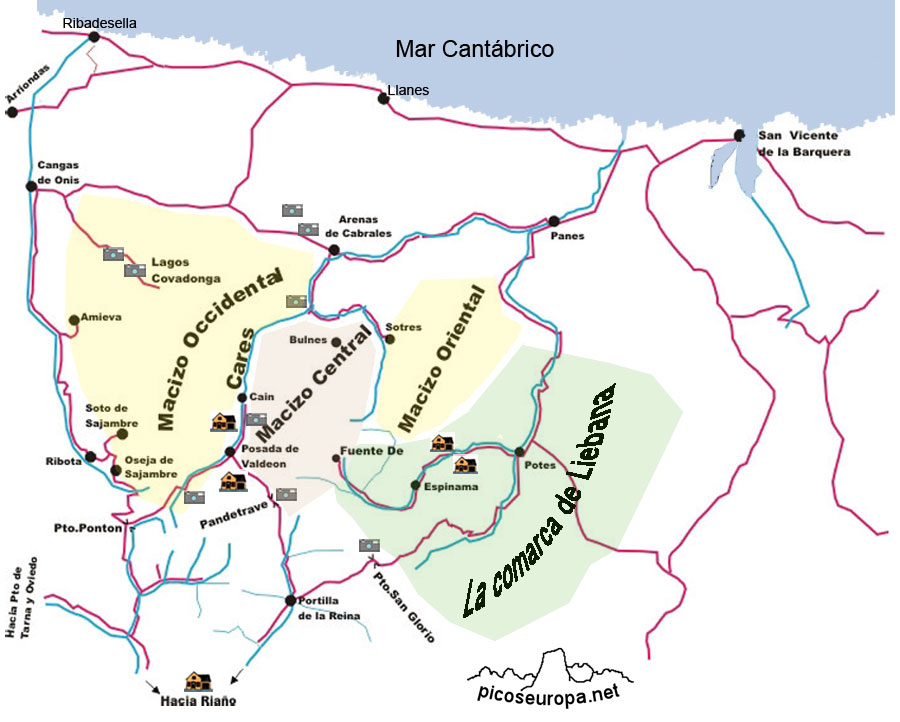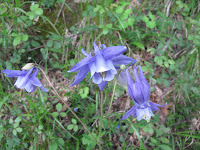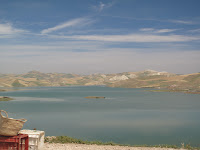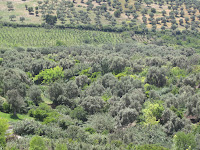Accompanied by our friends Paul Gratz and Timmi Perierra, we rented a big, comfortable, 4-door Peugeot and set off west toward Asturias. Our goal was to visit the national park, Picos de Europa. It's not a large park, covering only 650 square kilometers, but the effects of glacial erosion on the limestone massifs that form the Cantabrian mountains is very impressive. Tom and I have visited the park before and we vowed to return with better rain gear....yes, another place with plenty of rain...and take advantage of the hiking opportunities.
| Picos de Europa in red |
We walked over a high saddle and then down a few hundred feet until we reached the shores of Lake Ercina. We followed the shore and then climbed up another high saddle.
The view was spectacular. The high clouds and low fog drifted past the lake and the mountains, at times completely obscuring the view and other times tantalizing us with glimpses of rugged, snow covered peaks.
The hike continued through rocky limestone terrain alternating with velvet green meadows. It was some of the most beautiful hiking I've ever done. Paul and Timmi seemed to enjoy it too.
The gentians were especially stunning:
The following day, we followed the Cares river to the funicular that runs through the heart of the mountain to the little village of Bulnes, one of my favorite places in Spain or anywhere else in the world. It is accessible by funicular and by a 3 hour path, but not by road. The funicular opened in 2001 and runs a bit more than 2 kilometers at an 18% grade through the heart of the massif Peña Main. When I looked down at the path I was grateful for the funicular!
It's pretty thrilling to ride through the mountain, but that is secondary to the exhilaration you feel when you exit the funicular: you find yourself in a small valley with an ancient village that consists entirely of dove-grey stone buildings with red tile roofs. The village is bisected by a small, crystal clear river that is crossed by a small stone bridge. The snow-covered peaks loom over you and the sounds of dozens of cow bells fills the air.
We set off on a rocky climb up toward a point with a view of the famous peak called El Naranjo de Bulnes, because it picks up orange hues during sunset. That's the Naranjo on the left, peeking through the clouds.
The flowers were, again, distracting, as we made lots of new finds. Transhumance, where herds/flocks are driven up to high pastures for summer grazing and driven down to lower altitudes to over-winter, is still practiced in this part of Spain. Luckily, the cows were being driven up to Bulnes the day we arrived, so the numerous alpine flowers were still intact.
 |
| comfrey |
 |
| orchid |
 |
| wild primrose |
The next day, Tom arranged a special tour of the cave of El Castillo, which contains paleolithic art more than 40,000 years old. This means that the cave art was probably painted by Neaderthals, and has made scientists re-think previously accepted theories regarding the superiority of Homo sapiens. The caves of Altamira are much better known, but unfortunately for humans, is closed to preserve the fragile environment and the paintings. El Castillo is one of the last caves containing paleolithic art that is still open to the public although access is very restricted. It is a special and enchanting place, not solely because of the paintings, but also due to the spectacular rock formations within the cave. Photographs are not permitted, but if you would like to see some photos of the caves, follow this link.
http://news.nationalgeographic.com/news/2012/06/120614-neanderthal-cave-paintings-spain-science-pike/
















































